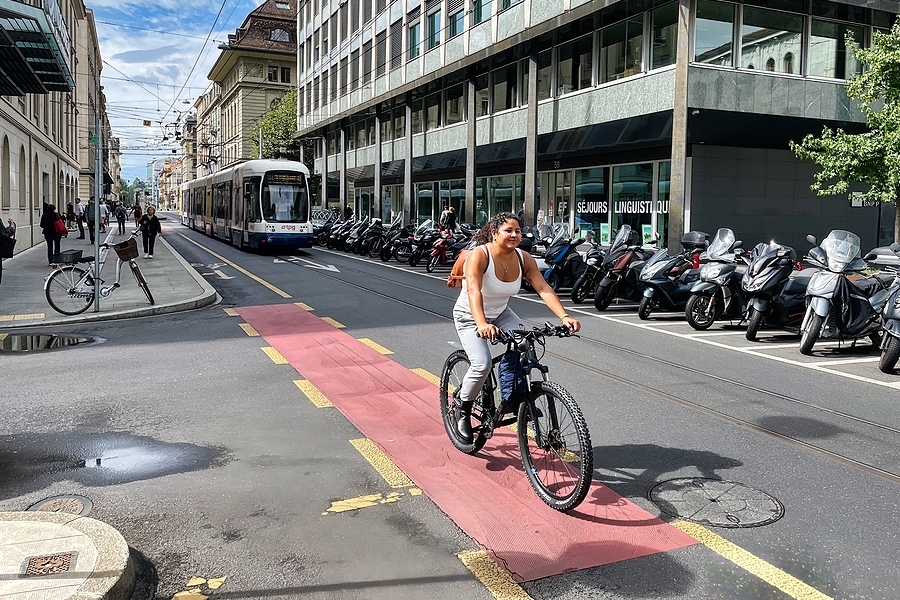Riding a bicycle should be fun, but there are far too many instances of negligent motorists causing severe injuries and tragic deaths. You deserve compensation if you suffered an injury in this accident or if a motorist hit your child. The attorneys with Sand Law are ready to help you get it. Keep reading to learn about Minnesota laws that keep cyclists safe.

Use our online contact form for a free case review, or call 651-291-7263.
Where Cyclists Can Legally Ride
In Minnesota, bicyclists can ride on all public roads except for limited access highways, such as freeways. Many cities in Minnesota have designated bike lanes on city streets, which are indicated by painted lines and signs. These bike lanes provide a dedicated space for bicyclists to ride, separate from vehicular traffic.
Bicyclists are also allowed to ride on sidewalks, except where prohibited by local ordinances. However, they must yield to pedestrians and give an audible signal before passing.
I Got Into an Accident Because a Motor Vehicle Driver Wasn’t Willing to Share the Road
A bicyclist can sue a motorist if they are involved in an accident and the motorist is at fault. In such cases, the bicyclist may recover damages for any injuries or losses incurred due to the accident. These losses include medical expenses, lost wages, pain and suffering, and property damage.
To prove that the motorist is at fault, the bicyclist must show that the motorist was negligent. Negligence occurs when a person fails to exercise reasonable care and causes an accident.
Examples of motorist negligence include:
- Failing to yield the right of way to the bicyclist
- Running a stop sign or red light
- Distracted driving
- Driving under the influence of drugs or alcohol
- Failing to check for bicyclists before making a turn
The bicyclist will also need to prove that their injuries or losses directly resulted from the accident and that they were not at fault.
Are Helmets Required for Cyclists in Minnesota?
Minnesota law doesn’t require cyclists to wear helmets, regardless of age. However, experts strongly recommend that all bicyclists, regardless of age, wear helmets to protect themselves from head injuries in case of an accident. While there are many laws that keep cyclists safe, this law allows cyclists to make a decision based on bodily autonomy.
The law may not require helmets, but they can be a crucial factor in protecting oneself from serious head injuries in case of an accident. Wearing a properly fitting helmet can reduce the risk of head injury by as much as 55%.
Stopping at Stop Signs and Stop Lights
Bicyclists must follow the same road rules as motor vehicles, including stopping at red lights and stop signs. This means that bicyclists must come to a complete stop at red lights and stop signs and wait for the traffic signal or for the cross traffic to clear before proceeding. If bicyclists disregard traffic signals and stop signs, police can cite them for a traffic violation. They could be held liable for any damages or injuries that result from their actions.
How Do Cyclists Signal Where They’re Turning?
Cyclists must use hand signals to indicate their intended direction of travel when turning or changing lanes. The standard hand signals include the following:
- Left turn: Extend your left arm straight to the side.
- Right turn: You can extend your left arm straight out to the side, with the elbow bent up at a 90-degree angle, or you can also use your right arm and extend it straight out to the side.
- Stopping or slowing down: Extend your left arm down, with the elbow bent at a 90-degree angle, pointing towards the ground.
Laws for Bicycling at Night
In Minnesota, there are specific laws that apply to bicycling at night. These laws include:
- Lighting requirements: Bicycles must be equipped with a white headlight and red tail light or reflector when operated at night. The headlight must be visible from a distance of at least 500 feet, and the taillight or reflector must be visible from at least 100 feet.
- Reflectors: Bicycles must also be equipped with reflectors on the tires’ pedals, spokes, and sidewalls. These reflectors must be visible from a distance of at least 600 feet.
- Clothing: Bicyclists are encouraged to wear reflective clothing or use reflective tape to increase visibility at night.
It’s ultimately the cyclist’s responsibility to ensure they are visible and take appropriate safety measures. This includes ensuring the bike is equipped with the proper lighting and reflective gear and obeying traffic laws.
What Can Cyclists Do to Avoid Car Accidents?
There are several things that cyclists can do to avoid car accidents and stay safe on the road. First of all, you should follow the laws that keep cyclists safe. Second, you should do the following:
- Be predictable: Ride in a straight line and signal your intentions to other road users. Avoid sudden swerves or turns that can surprise drivers.
- Avoid distractions: Don’t use your phone or listen to music while cycling. Keep your attention on the road at all times.
- Check your equipment: Before each ride, ensure your bike is in good working condition, with properly inflated tires, functioning brakes, and appropriate lighting.
- Look out for hazards: Be aware of your surroundings, anticipate potential hazards such as potholes, debris, and parked cars and be prepared to take evasive action.
- Be prepared for inclement weather: Make sure you have the appropriate gear for the weather conditions, and be aware that it can affect visibility and road conditions.
Steps to Take if You’re Hit by a Car
If you’re hit by a car while riding a bicycle, it is essential to take the following steps:
- Check for injuries and seek medical attention immediately. Even if you feel fine, it is crucial to have a medical professional check for any internal injuries or trauma.
- Call the police and report the accident. The police will document the accident and create a report that you can use in any insurance or legal claims.
- Get the contact and insurance information of the driver of the car. If there are any witnesses, get their contact information as well.
- Take photos of the scene of the accident, including any damage to your bicycle and the car.
Contact Sand Law ASAP After Your Bicycle Accident
These Minnesota laws keep cyclists safe, but they’re not foolproof in preventing accidents. If you’ve been hurt in a bicycle accident, it’s time to seek assistance.
It’s just as vital for you to get legal help as it is to get medical help. The attorneys with Sand Law will be ready to work to get maximum compensation on your behalf. Call 651-291-7263 or contact us online for a free consultation.

